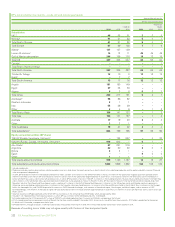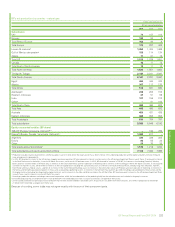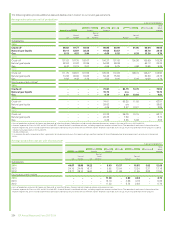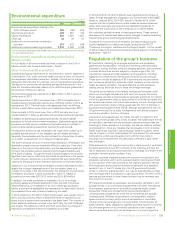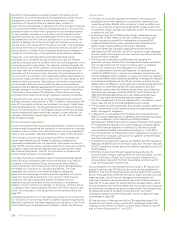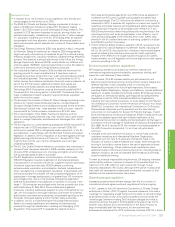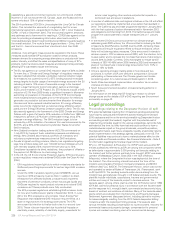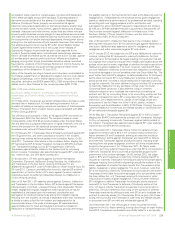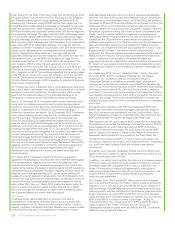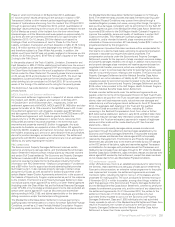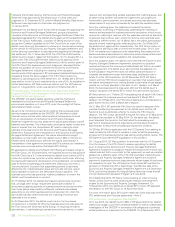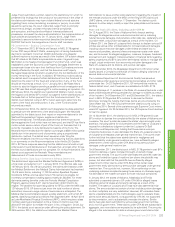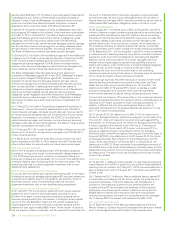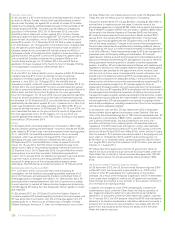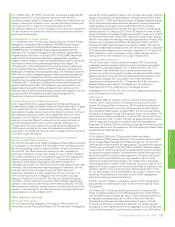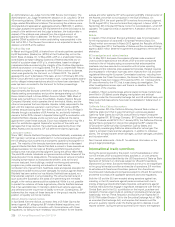BP 2014 Annual Report Download - page 236
Download and view the complete annual report
Please find page 236 of the 2014 BP annual report below. You can navigate through the pages in the report by either clicking on the pages listed below, or by using the keyword search tool below to find specific information within the annual report.
Following the fairness hearing, the Economic and Property Damages
Settlement was approved by the district court in a final order and
judgment on 21 December 2012, and the Medical Benefits Class Action
Settlement was approved in a final order and judgment on
11 January 2013.
Subsequent to the district court’s final order and judgment approving the
Economic and Property Damages Settlement, groups of purported
members of the Economic and Property Damages Settlement Class (the
Appellants) appealed from the district court’s approval of that settlement
to the Fifth Circuit. Additionally, a coalition of fishing and community
groups (the Coalition) appealed to the Fifth Circuit from an order of the
district court denying it permission to intervene in the civil action serving
as the vehicle for the Economic and Property Damages Settlement and
further denying it permission to take discovery regarding the fairness of
that settlement. On 11 November 2013, the Fifth Circuit affirmed the
district court’s rulings in respect of the Coalition. On 10 January 2014, a
panel of the Fifth Circuit affirmed the district court’s approval of the
Economic and Property Damages Settlement but left to another panel of
the Fifth Circuit (the business economic loss panel, discussed further
below) the question of how to interpret the Economic and Property
Damages Settlement, including the meaning of the causation
requirements of that agreement. BP and several Appellants filed petitions
requesting that all the active judges of the Fifth Circuit review the
decision to uphold approval of the settlement. On 19 May 2014, BP’s en
banc petition to the full court was denied by a vote of 8-5. As explained in
further detail below, BP filed a certiorari petition with the US Supreme
Court on 1 August 2014, which was denied on 8 December 2014.
PSC settlements – Deepwater Horizon Court Supervized Settlement
Program (DHCSSP) and interpretation of the Economic and Property
Damages Settlement Agreement
The DHCSSP, the claims facility operating under the framework
established by the Economic and Property Damages Settlement,
commenced operation on 4 June 2012 under the oversight of Claims
Administrator Patrick Juneau.
As part of its monitoring of payments made by the court-supervized
claims processes operated by the DHCSSP, BP identified multiple
business economic loss claim determinations that appeared to result
from an interpretation of the Economic and Property Damages
Settlement Agreement by that settlement’s claims administrator that BP
believed was incorrect. This interpretation produced a higher number and
value of awards than the interpretation BP used in making its initial
estimate of the total cost of the Economic and Property Damages
Settlement. Pursuant to the mechanisms in the Economic and Property
Damages Settlement Agreement, the claims administrator sought
clarification on this matter from the district court in MDL 2179, and on
5 March 2013 the district court affirmed the claims administrator’s
interpretation of the agreement and rejected BP’s position as it relates to
business economic loss claims (the March 2013 Ruling).
BP appealed the district court’s March 2013 Ruling and related rulings to
the Fifth Circuit. On 2 October 2013, the business economic loss panel of
the Fifth Circuit (by a 2-1 vote) reversed the district court’s denial of BP’s
motion for a preliminary injunction and the district court’s order affirming
the claims administrator’s interpretation of the settlement, remanded the
case for further proceedings and ordered the district court to enter a
’narrowly-tailored’ injunction that suspended payment to claimants
affected by the misinterpretation issue and who did not have ’actual
injury traceable to loss from the Deepwater Horizon accident’. The
business economic loss panel also retained jurisdiction to review the
district court’s conclusions on remand.
On 18 October 2013, the district court issued a preliminary injunction
that, amongst other things, required the claims administrator to
temporarily suspend payments of business economic loss claims other
than those claims supported by sufficiently matched accrual-basis
accounting or any other business economic loss claim for which the
claims administrator determines that the matching of revenue and
expenses is not an issue.
On 24 December 2013, the district court ruled on the two issues
remanded to it in October 2013 by the business economic loss panel of
the Fifth Circuit (the December 2013 Ruling): (1) requiring the claims
administrator, in administering business economic loss claims, to match
revenue with corresponding variable expenses (the matching issue), and
(2) determining whether the settlement agreement can properly be
interpreted to permit payment to business economic loss claimants
whose losses (if any) were not caused by the spill (the causation issue).
As to the matching issue, the district court ordered the claims
administrator to develop a revised policy addressing the matching of
revenue and expenses for business economic loss claims, which would
require the matching of revenue with the expenses incurred by claimants
to generate that revenue, even where the revenue and expenses were
recorded at different times. On 13 March 2014, the claims administrator
issued a revised matching policy reflecting this order. On 5 May 2014,
the district court approved the revised policy. The PSC filed a motion on
27 May 2014 seeking to alter or amend the revised policy. On 27 June
2014, the district court issued an order establishing the process for the
parties and claims administrator to determine which already-determined
but unpaid claims should be subject to the revised policy.
As to the causation issue, the district court ruled that the Economic and
Property Damages Settlement Agreement contained no causation
requirement beyond the revenue and related tests set forth in an exhibit
to that agreement. The district court also held that the absence of a
further causation requirement does not defeat class certification or
invalidate the settlement under the federal class certification rule or
Article III of the US Constitution. On 30 December 2013, BP filed a
motion with the Fifth Circuit requesting an injunction that would prevent
the claims administrator from making awards to claimants whose alleged
injuries are not fairly traceable to the spill. In a 2-1 decision on 3 March
2014, the business economic loss panel affirmed the district court’s
ruling on causation and denied BP’s motion for a permanent injunction.
BP filed a petition on 17 March 2014 requesting that all active Fifth Circuit
judges review the business economic loss panel’s 3 March 2014
decision. On 19 May 2014, the Fifth Circuit declined (in a 5-8 decision) to
grant further review of the 3 March 2014 decision.
On 21 May 2014, BP asked the Fifth Circuit to stay the issuance of the
mandate transferring the case back to the district court until the US
Supreme Court could decide whether to review the Fifth Circuit’s
decision. The Fifth Circuit denied BP’s request for a stay on 27 May 2014,
and issued its mandate on 28 May 2014. On the same day, the district
court dissolved the injunction that had halted the processing and
payment of business economic loss claims and instructed the claims
administrator to resume the processing and payment of claims.
On 28 May, BP filed an application with the US Supreme Court seeking to
recall and stay the Fifth Circuit’s mandate in order to halt the processing
and payment of business economic loss claims pending further review. The
US Supreme Court denied BP’s application on 9 June 2014.
On 1 August 2014, BP filed a petition for certiorari with the US Supreme
Court for review of the Fifth Circuit’s decision upholding the district
court’s ruling that the Economic and Property Damages Settlement
Agreement contained no causation requirement beyond the revenue and
related tests set forth in an exhibit to that agreement, as well as a related
decision by a different panel of the Fifth Circuit similarly interpreting the
Economic and Property Damages Settlement Agreement to permit
payment to business economic loss claimants whose losses (if any) were
not caused by the spill. The US Supreme Court denied BP’s petition for
certiorari on 8 December 2014. Accordingly, the effective date of the
Economic and Property Damages Settlement Agreement is 8 December
2014, and the final deadline for filing all claims other than those that fall
into the Seafood Compensation Program is 8 June 2015.
On 2 September 2014, BP filed a motion seeking an order removing
Patrick Juneau from his roles as claims administrator and settlement
trustee for the Economic and Property Damages Settlement. On
10 November 2014, the district court denied BP’s motion. BP appealed
this decision to the Fifth Circuit on 18 November 2014.
For more information about BP’s current estimate of the total cost of the
PSC settlements, see Financial statements – Note 2.
PSC settlements – investigation of the DHCSSP
On 2 July 2013, the district court in MDL 2179 appointed former federal
district court judge Louis Freeh as Special Master to lead an independent
investigation of the DHCSSP in connection with allegations of potential
ethical violations or misconduct in the DHCSSP. On 6 September 2013,
232 BP Annual Report and Form 20-F 2014


